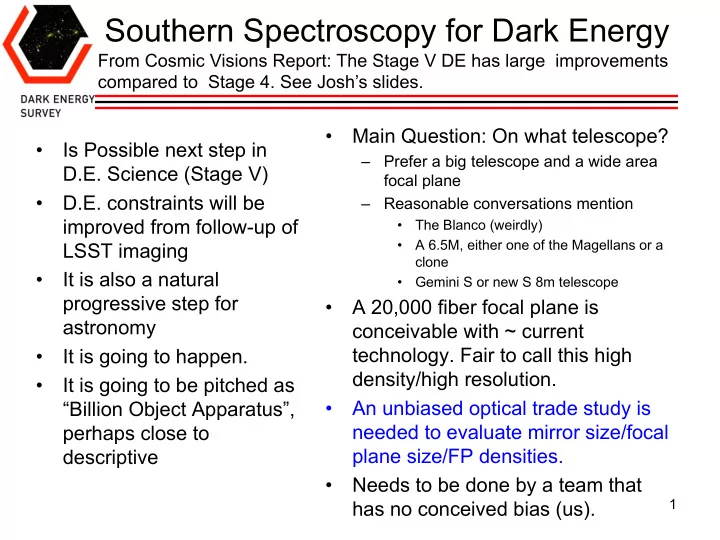

Southern Spectroscopy for Dark Energy From Cosmic Visions Report: The Stage V DE has large improvements compared to Stage 4. See Josh’s slides. • Main Question: On what telescope? • Is Possible next step in – Prefer a big telescope and a wide area D.E. Science (Stage V) focal plane • D.E. constraints will be – Reasonable conversations mention improved from follow-up of • The Blanco (weirdly) • A 6.5M, either one of the Magellans or a LSST imaging clone • It is also a natural • Gemini S or new S 8m telescope progressive step for • A 20,000 fiber focal plane is astronomy conceivable with ~ current technology. Fair to call this high • It is going to happen. density/high resolution. • It is going to be pitched as • An unbiased optical trade study is “Billion Object Apparatus”, needed to evaluate mirror size/focal perhaps close to plane size/FP densities. descriptive • Needs to be done by a team that 1 has no conceived bias (us).
Dark Energy Constraints / R&D Will Saunders, AAO • R&D is needed to get the fiber positioner pitch from 8 mm to ~5 mm. • We successfully convinced “Cosmic Visions Dark Energy: Small Projects Portfolio” to make this a priority. DESpec Mohawk • Understand, replicate, improve the FP Counterweight technology. Collaborate w/ AAO, perhaps. • We have the experience and skill to lead a Pivoting ball instrument project with 20,000 fibers. Carbon fibre tube Trimming weight Tapered tube Stainless steel tube Will Saunders, AAO Fibre tip
Extra Slides 3
Support 4 “Skipper CCD” Realtime Control BTW, a Skipper CCD doesn’t really skip • At cost of readout time, it enables reduction of RO noise by 1/sqrt(N) reads. • Applications include Ly- a forest spectra with low-signal absorption lines – – Low signal emission lines • If one has a prior for where the lines are then one could do the trick in their neighborhood only. Or maybe even decide on the fly based on the signal level, decide how many reads are needed, optimizing the RO time. Spectrum from LDSS3 w/ DES-style CCD. Has RO noise 7.1 pixels. 4
A piece of Fiber Positioner R&D “DESpec: A good idea ahead of its time” Cosmic Visions Photo: Will Saunders Nov. 15, 2017 5
Optical Fiber Positioners Skipped a step: economics that drives us to fiber positioners • Precisely hold the tip of optical fibers on the desired RA & DEC of the galaxy (specs typical of Echidna Mark 1) – Premium on small (7 mm) spacing between actuators (pitch) – ± 0.14” (± 1/2 pixel on DECam) position accuracy corresponds to ±7.5 um. – 60” target separation is ~3.2 mm spacing between fiber tips – Fast reconfiguration time: 90 seconds or less – Maximum throughput, highly reliable … • Tilting Spines and Twirling Posts – Advantages/Disadvantages for each type (discuss at length) – Relatively high density of positioners on the focal plane made Tilting Spines the best choice for DESPec – The new Tilting Spine design (J. Gilbert & G. Dalton SPIE 2016) alleviates the spine’s disadvantages 6
Mohawk Tilting Spine • 6 ¾ mm pitch Counterweight • Length about 16 cm Pivoting ball • Patrol radius ~ 7 mm • Positioning accuracy < 10 microns is already achieved Carbon fibre tube • Improved configuration time is Trimming weight about 60 seconds. • Issue of “tilt defocus” drives the design to long spines. Tapered tube Stainless steel tube • New design low-voltage spine Fibre tip (2016) Echidna spine picture from Graham Murray (Durham) 7
MOHAWK fiber positioner • 4000 spines, 450mm Focal Plane diameter, 6.75mm pitch. • Curved modules, each with two rows of spines, fit together like staves of a barrel to Will Saunders, AAO form spherical surface.
Spines vs Twirling Posts • Tilting Spines • Twirling Posts – Pitch 6 mm – Pitch 10 mm – Patrol Radius ~ 1.2 * pitch – Patrol radius ~0.7 * pitch – Maximum packing ~ 7 – Maximum packing ~ 2 – 6 or 7 parts maybe 10 in – ~ 28 parts Model 2 – Faster to position than – Better targeting efficiency initial spine versions – More effective for close targets – Light loss with tilt – FRD affects sky subtraction – Both above are mitigated by longer spines 9
Fiber Positioner R&D Strategy? • Understand & replicate the technology. Collaborate w/ AAO, perhaps. • Engineering: – Reduce the pitch, how? – Increase the length • Incremental improvements have a big payoff because of r^2 10
Recommend
More recommend